It may seem like a mundane and not-so-exciting project, but I’ve been tackling the problem of whitening a piece of yellowed embroidered linen these days. In addition to whitening the linen, I need to replace the lace and do some minor repair work.
But first things first: the linen is Sooo Very Yellow with (not very old) age and use, and there is a significant stain on it.
The piece I’m working with is an embroidered linen pall that I made years ago, which I wrote about here and here. It is, in fact, only 11 years.
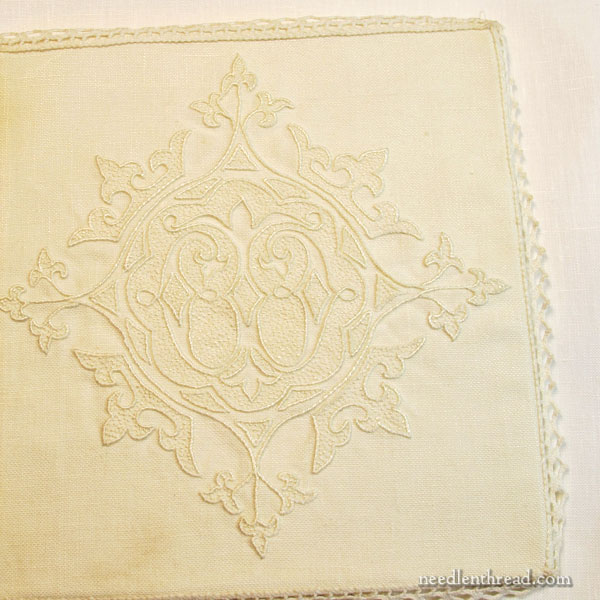
When we think about yellowed linen, usually we think in terms of “vintage” or “antique” linen. Fabrics – especially white fabrics that are sitting around in drawers or storage – tend to yellow over time, depending a lot on the environment they’re in, the way they’ve been used, and whether or not they were cleaned and stored conscientiously.
But with a piece of ecclesiastical linen like this, it does get used (I assume daily), and it doesn’t get cleaned very often. But it should get cleaned more often than this piece was cleaned, especially if it is used daily. Most small church linens, if cleaned regularly, don’t get into this shape.
I’ve explained before what a pall is, but to clarify for those who are just joining us on the subject, this type of pall is not to be confused with a funeral pall in liturgical services, although there is a symbolic connection between the two types of palls. This particular little square of linen is used to cover a chalice during the liturgy, for a very practical reason (it keeps things out of the wine).
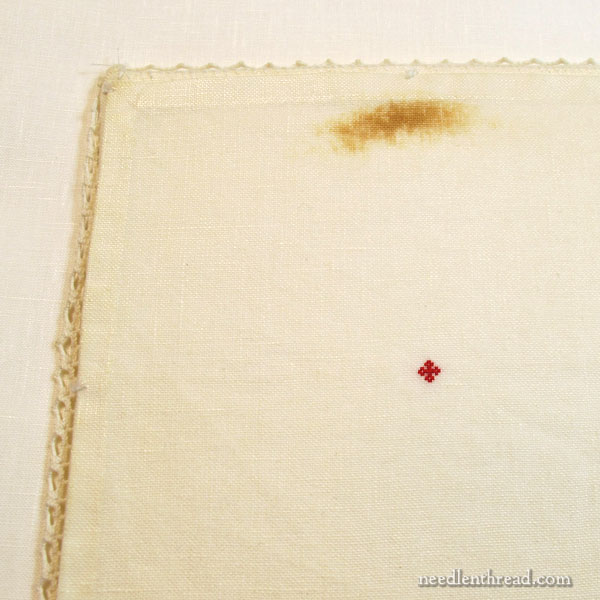
So it is not unusual for the linen that touches the edge of the chalice to get stained if there is any wine on the edge of the chalice.
This particular pall has an extra linen backing on it – a small, finished square of linen, hemmed, with a red cross embroidered in the middle, and which is tacked onto the back of the main “body” of the pall. The reason for this backing is that it can easily be removed and laundered and replaced, in case it gets stained. That plan didn’t work out so well.
Anyway, the pall came back to me for some attention, and I’m happy to see what I can do about getting back into usable shape.
I’m not trying to bring the linen to an optical white. It was not an optical white to begin with. It was a natural white. But I do want to lighten or eliminate the yellowing as much as possible and remove the stain completely.
As it is now, it is simply not usable. It is too yellow and too stained.
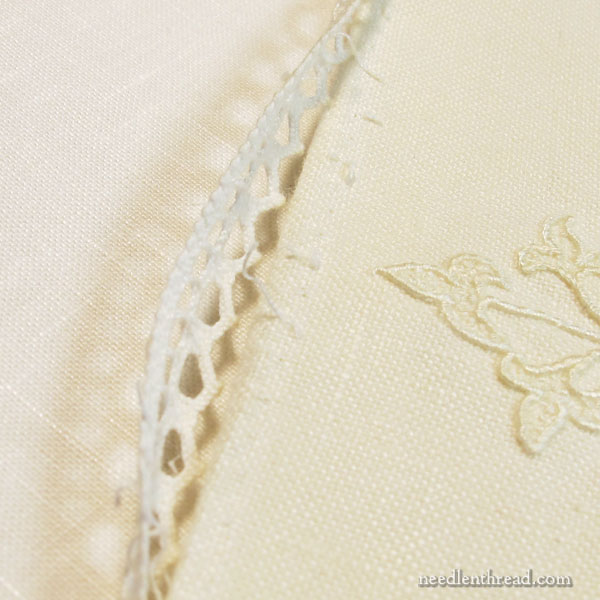
So my goal is to whiten it as much as I can, remove the stain, repair a little corner area where the original sewing has deteriorated a bit, and replace the lace.
I started by taking the whole thing apart: removing the linen square on the back, removing the lace (in the photo above, you can see the difference in the fabric where the lace was removed), opening the seam and removing the inside board.
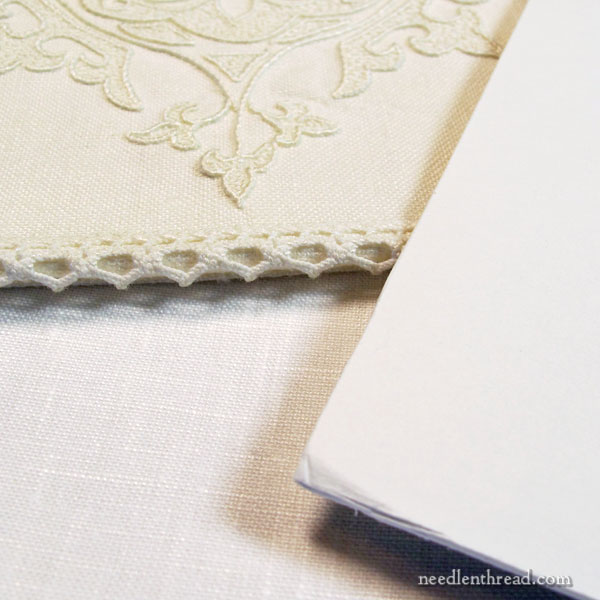
There’s a board (archival mat board) in the middle, that the linen encases in order to keep the pall stiff. The board is in pretty good shape, all things considered!
Still, I’ll replace the old one with a new one.
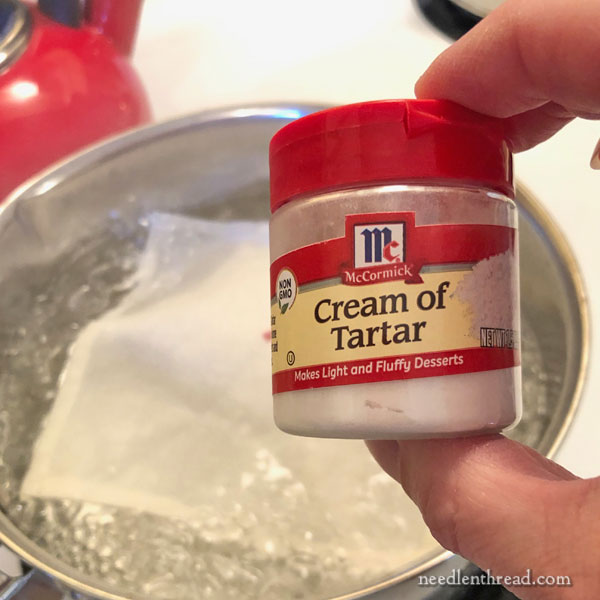
This is one of those situations where I will move from less aggressive methods of stain removal and cleaning to more aggressive.
Keep in mind that there are many ways to go about cleaning linens and other textiles and whitening old linens, and folks who do this kind of thing tend to have their favorite ways. In this article, I’m not demonstrating every possible way to do it. I’m just taking a series of steps to see if I can arrive at a usable level of cleanliness and whiteness.
When you’re working with linens that you’d like to save and be able to use, always start with the least aggressive cleaning methods and move to the more aggressive. While you don’t necessarily want to contribute to the quick deterioration of the fabric by using harsher chemicals, bleach, and the like, remember that if it can’t be used as is, it’s better to get aggressive and get it usable, if your plan is to use it. Otherwise, it just remains non-usable and it will deteriorate over time, anyway.
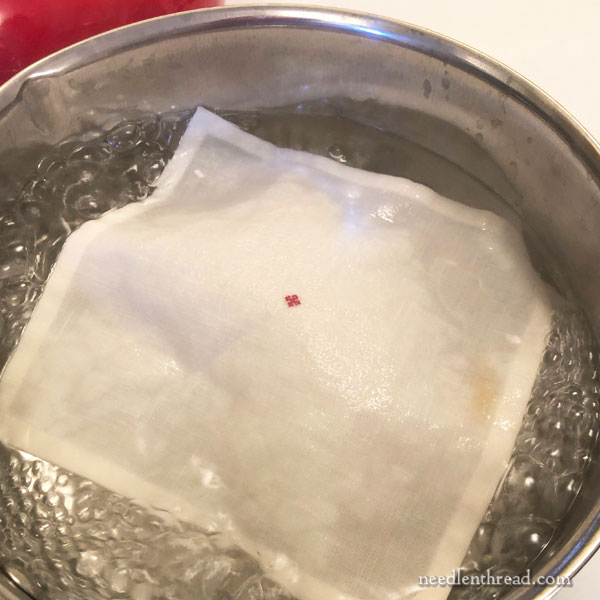
I started with my favorite method of cleaning stained smaller pieces of white linen. I boiled the linen pieces in water on the stove, adding cream of tartar to the boiling water.
After my standard ten minute boil, I checked progress, and I wasn’t impressed. The stain had lightened, but it was still there, and the yellowing was still problematic.
This method usually works very well with wine stains, but I suspect that it’s more effective on newer stains. This is an old stain.
So I left the linen to boil, refreshing the pot with water if the water line decreased too much, for about an hour
It didn’t make as much of a difference as I would like, so it was apparent that I would have to get more aggressive.
Time to bring on something acidic!
Good Thing I Don’t Have a Cat!
If you have ever seen the BBC’s delightful adaptation of Elizabeth Gaskell’s Cranford starring Judi Dench and other well-knowns, you might recognize my next method. If you haven’t seen it, I recommend it – and please do enjoy the scene where the cat drinks the buttermilk, along with the lace soaking in it, and ends up in the boot.
I’ve read in many old publications about using buttermilk to whiten linens. I’ve never actually tried it myself, but I figured why not? It’s a good opportunity to try it!
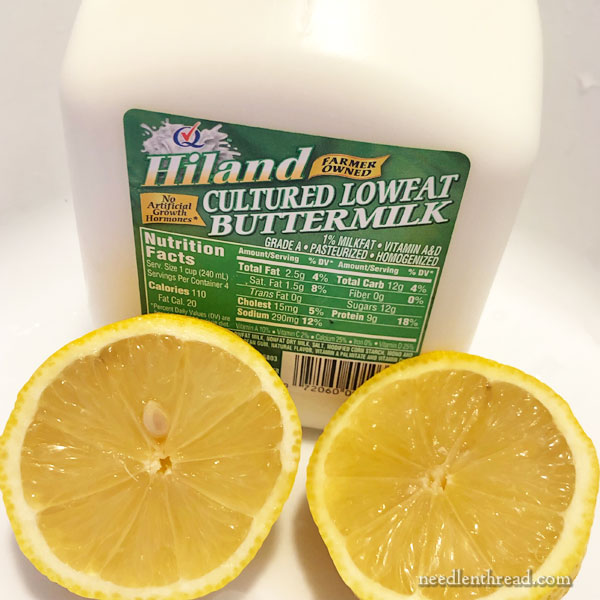
To prepare a buttermilk bath for soaking textiles, mix about a quart of buttermilk in a tub with a gallon of water, and squeeze in some fresh lemon juice (maybe a tablespoon or so). Stir it up and put your linen in to soak for 24 hours.
I did this.
It’s kind of disconcerting to see the separated buttermilk after 24 hours, with the buttermilk-coated linens languishing beneath the yellowy surface of the whey. The lemon is surely the culprit, since commercial buttermilk doesn’t usually separate to this degree at this speed.
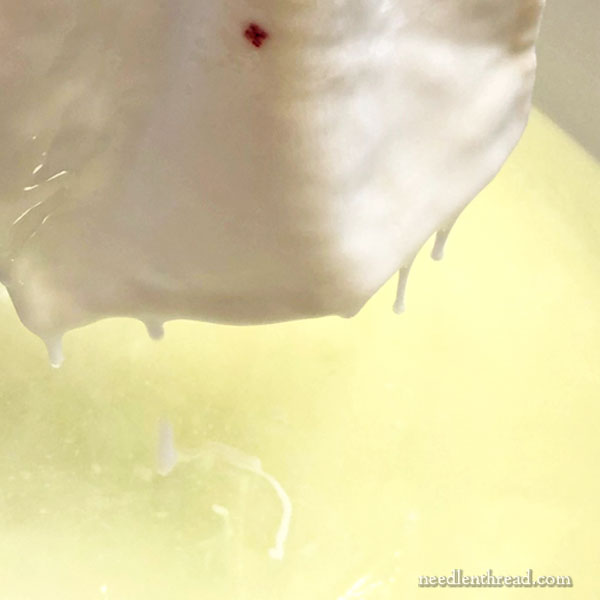
The linen was a bit gooey when I retrieved it.
It did lighten up considerably, and the stain faded considerably as well. Unfortunately, I forgot to snap a photo before I moved on to the next stage.
It’s not where I want it to be, so, after rinsing the linen thoroughly, I set it in a tub to soak overnight again in warm water with a little liquid Ivory detergent in it. This is just an in-between soaking stage, I’m sure. I just didn’t want the linen drying overnight. Today, I’ll examine the results of the buttermilk soak and the overnight Ivory soak a little more closely.
Never underestimate the power of soaking, by the way. Sometimes, you might have to soak a linen for 24, 48, 72 hours or more before you get the results you want. If you’re going to soak the linen for a long time, it is better to do so in a milder detergent, rather than in a harsher detergent. Usually, with the harsh stuff, you’re not going to need a super long soak, and harsher detergents can speed up the fabric deterioration.
I suspect that I will need to move on to at least one more stage, which is the stage where I use Biz, or perhaps Biz and Oxyclean.
Oxyclean will often do the trick, but use it with caution. If your embroidery is done with silk threads, avoid it. It’s not good for silk! It takes the natural sheen away and can even disintegrate the threads. The embroidery on this, I believe, is cotton. (I can’t remember absolutely!) I thought it was silk, but in going back through my notes, I see mention of “whitework threads.” If I had used silk, I would have said silk.
So that’s where I am now. I will keep you abreast of the outcome and the stages I take to get there!
Worst case scenario: I embroider a new one.
(Or is that the best case scenario?)
I’ll let you know!




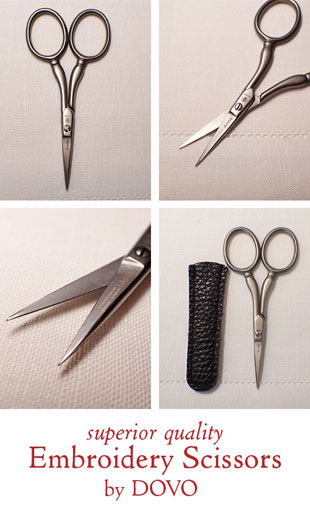

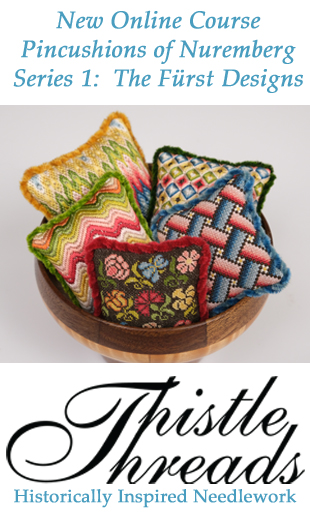
Hi Mary – interesting article. Is there a reason you didn’t mention Orvus?
Hi, Kathryn – I use Orvus for soaking some things, but not for heavily soiled / yellowed items. Orvus is simply sodium lauryl sulfate, and while it works for some applications, it doesn’t work as well for others. Plus, you have to take a few things into consideration when using Orvus. For example, it doesn’t work as effectively if you have hard water. (And if you have very hard water, it’s completely ineffective.) It can be problematic for certain fibers, especially if you use anything acidic with it (like adding vinegar to a rinse). And it can wreak havoc on your skin. Orvus has a kind of dedicated following, where people believe it is the most gentle cleaner you can use, but it’s really not, and it’s not always the most effective. It does have a neutral pH, but there are other cleaners that work more effectively and just as safely. It all depends on what you’re trying to do. So, I do use it for some things, and I’ve written about it before here on Needle ‘n Thread (I’ve learned a lot more about it and other cleaners since then), but in this case, I probably wouldn’t opt for Orvus.
This was really interesting! I’d never heard of using cream of tartar before. I have several crocheted doilies that my mother gave me that have yellowed a bit so I’ll give it a try.
I was wondering if there are any times when you would say it’s not a good idea to even try to take out the stains. Last night, I was looking at some state birds that my mother and I had embroidered when I was a kid — maybe around age 10 — so the embroideries themselves are about 50 years old. The other thing is that they were embroidered on a thin (likely not great quality) white cotton and have lots of small stains (probably from my fingers) on them. I was thinking about sewing the embroidered squares into a quilt, but at some point I have to wash them. I’d have to finish the edges so they don’t fray like crazy, but wash them BEFORE I sew them together or wait until AFTER (like after I’ve quilted the top)? What would you recommend? I’d hate to do all the work and then have them dissolve the first time I washed them.
Thank you.
I would say wash them first, if you plan on washing them at all. If there are any problems, best to know that now and not after you put a lot of work into them. Can you soak them? That would reduce the stress on the fabric that you can get from actually washing them (as that introduces an abrasive element – even if just fabric rubbing on fabric).
Hi Mary! Have you tried a product like Engleside Restoration Powder to clean antique and delicate linens safely? I think this product isn’t available right now, but there are others like it. I’ve used this one on some old stained and yellowed linens and was amazed at how well it worked!
I can’t wait for the next installment of your pall adventure!
Yes, I have some – and I’ve written about it here on the website. It’s not too dissimilar from Oxyclean. It does work well. Right now, though, since I have the opportunity, I’m experimenting with a few different methods that are lesser known, just to see how they work!
You are correct about the lemon separating the buttermilk. Have a bunch of milk about to go bad but you’ll never drink it all first? Make pan cheese with it and lemon juice (or vinegar).
I’ve heard of the cream of tartar for whitening, but not the buttermilk. I think the one time I had to try whitening fabric it was vintage embroidered dresser scarves and such and I went right to very hot water and oxygen bleach. At the time, I had forgotten about gentler methods – stress can do that :-O
Dear Mary
What a great way to wash linen when stained. I never thought of soaking for such a long time but it looks as though it has helped, I hope you able to remove the stain and bring the linen up to its former glory. I did see the Cranford episode you mentioned and it was very amusing and brilliant program. These kind of natural remedies are often the best way to brighten or remove stains. Thanks for sharing with us this technique for washing linens and removing stains very helpful.
Regards Anita Simmance
Interesting! I’ve had good luck with Restoration Fabric Restorer. It cleaned and perfectly restored a white linen tablecloth that looked like it had been folded in a drawer for decades with the resulting brown stains on various areas. It doesn’t work on everything, but is definitely worth a try. Good luck!
Yep, I’ve used Restoration! I think I’ve even written about it at one point, when discussing vintage linens. It’s not too dissimilar from Oxyclean.
Hi! So I found some old pillow cases made by my great grandmother. The part with the embroidery is still white, but the rest of the case is yellow due to aging. Any ideas? Or any ideas on how to repurpose the embroidery? The embroidery is beautiful, and making a tiered apron using the embroidery parts seems like a bit of a waste due to future stains, but it’s not worth framing it.
Great suggestions, Mary! Would Borax also work?
Yes, I’ve used Borax. Dissolve it well! Some folks combine Borax with other cleaners, too.
I am SO glad you are addressing this issue. I have a soft spot for old, embroidered linens and just can’t get them as clean as I would like. I hope others chime in here with more tips. Right now, I have a plethora of brand-new, old hankies that were in a salesman’s book. But they are discolored and with rust stains from the pins that attached them to the pages of the book. It’s the rust stains that have me the most flummoxed. Help!
I’ve heard good things about a product called Retro Clean.
Ah, stain removal. What joy. Have you ever used orvis soap? I haven’t used it myself, but have heard it being used on antique quilts.
Hello Mary,
I went through steps similar to yours to try to remove the yellow and some stains from an old crocheted, cotton apron. I found that Retro Clean (www.retroclean.com) did the job. I think it’s about the same harshness as Oxyclean.
Good luck!
Judy
Yep, I have Retro Wash and Retro Clean. Right now, I’m just experimenting with different, lesser-known approaches, since I have the opportunity.
Ack! I had no idea about Oxyclean eating silk. I’ve been using it for several years on clothing because I had this memory of my mother saying that oxygen bleach (which I assume Oxyclean is?) was easier of fabrics than chlorine bleach. Good to know the truth!
I’ve never heard of buttermilk but I’ve used baking soda and lemon with great result quite a few times. Also, don’t underestimate a good couple of days in the sun, soak dry flat in the sun, repeat until level of whiteness is good. Combine with baking soda and lemon soak and it’s done in a few days time. Well, this was with linen that turned yellow due to age so I’m uncertain how well it would work with a piece loke yours 😛
Quite by chance I read somewhere about soaking stained linen in a bowl with washing-up liquid (gentlest ecological liquid). It worked wonderfully on an Edwardian tablecloth that had a large yellow stain. I presumed that it would be gentler than Bio-tex type products. Was I mistaken? Thanks
No, I think you’re probably right. You’d have to compare ingredients and whatnot. Sometimes, when a product is called “ecological” and so forth, it’s really just marketing. Looking at what it’s made of will give you a better idea of whether it’s a mild or an aggressive cleaner.
Hi Mary,
Try the product called Orvus paste. I read about it in one of Janice Love’s Hardanger books. A little goes a long way, it is very sudsy so only use a little and it works. It is a horse product, all natural – google it. It is also available on Amazon. When I purchased my container, I had to go to a Garden/animal supply store. I have used it for nearly 30 years. I wish I were near you so I can give you some of mine – it lasts forever!
Does anyone know what happened to Janice?
Good Luck.
Hi, Susan – I’ve written about Orvus before here on Needle ‘n Thread. I do like it for a good soak, but it doesn’t seem to work that great for severe yellowing. I’ve soaked things for four and five days, changing out Orvus, and not had the results I’ve wanted. So, while I like it for gentle soaking when there’s no severe discoloration, it’s not really the “big guns.”
If I could attach a photo here of Janice Love it is from when I saw her almost exactly two years ago October as a vendor selling at the 60th National Seminar 2018 held in Louisville, KY of the Embroiderers’ Guild of America. I was excited to see her there too as I consider her Hardanger books the bible reference of that technique, appreciating that how to correct cutting errors and the back of stitching sequences are included.
Thank you. I have old embroidered/stamps that have unknown stains. I tried blue dawn and later a bit of bleach.. ugh..I hope to find something that works.
Hi Mary! I make palls for churches and found that using plexiglass for the square in the middle is a game changer. I stitch the pall around the plexiglass. The pall can be immersed in lukewarm water to be cleaned when stains happen and is air dryed on top of a cup. The linen shrinks just enough to take out all of the wrinkles and the pall looks new.
Hi, Jan – There are several reasons I don’t normally use plexiglass (unless it’s requested), not least among them is that most people I’ve made palls for do not like plexiglass for the core. It’s thicker (even the “thin” stuff) and significantly heavier. The main reason I don’t personally like it is that it requires time and mess to sand the edges and corners. I generally use a dremel for this, for those who want plexiglass. The plexiglass takes a toll on the linen – the sharp edges and corners require some kind of sanding, to keep them from cutting into the fibers over time. I’ve found that you can special order custom-cut white plexiglass with rounded, smooth edges, but wow. It’s pricy! So I generally do that part myself, but it is time consuming and messy. I prefer board, because it’s affordable, it’s archival, it’s easy to come by, it’s easily replaced, it is light but sturdy, it’s opaque, it’s easy to cut… etc etc…
I don’t know if you have tried Orvus or not, but it works wonders. I first learned of it when I was at an antique show. I was chatting with one of the dealers who featured linens of all sorts. She highly recommended Orvus saying she soaked all of her linens in it. I didn’t act on it right away, but at another show, a completely different dealer told me the same thing. I went on a search. I found Orvus at a saddlery. Yes, it is originally horse shampoo. I have noticed that many stitch shops are beginning to carry small bottles of Orvus, but when I first bought it in the late 1990’s, I had to buy a gallon. I still have over half of it and have given away lots. Just a small amount seems to be all you need. I just soak in warm water with a dab of Orvus, rinse completely, and dry. No stains, no yellowing.
Hi, Joan – If you read through the comments, you’ll find my previous reply about Orvus.
I’ve had excellent luck with “Mama’s Miracle Linen Soak.”
Hi Mary – Your comment about hard water is spot on. The quality of water never seems to be mentioned when recommendations are being made about cleaning embroideries/etc. Yet it is really one of the most important aspects of cleaning. If the water quality is not excellent (including little chlorination; soft (no dissolved minerals); no smell) and abundant, any cleaning may actually be harmful by leaving behind more contamination from the water and the inadequately rinsed out detergent and bleaches. In the field of textile conservation now, Orvus (sodium lauryl sulfate) is no longer used for the protein fibres as the Orvus interacts with the fibre molecules and is almost impossible to rinse out of protein fibres.
Exactly! Thanks, Margaret!
Mary, do you ever use 3 pct hydrogen peroxide for whitening pieces? I have had very good results by saturating yellowed or wine-stained linens with 3 pct peroxide. If the wine stain is fresh, sometimes just dampening the stained area with peroxide straight from the bottle, and keeping it damp for 15-30 min, will remove the stain. For aged yellowing, I soak the piece in a weaker solution of half 3 pct and half water, seal the item in a plastic bag so it stays wet, and wait, overnight to up to 3 days. A caution is that peroxide will bleach colored cottons, but with plain white pieces, it works great. Perhaps this would be too harsh for heirloom pieces, but it has worked well on my inherited pieces and thrift shop finds.
Hi Mary … what an interesting journey into the world of stains and restoration. Do you have any ideas on removing a yellow stain on a Christening gown made of Swiss voile and embroidered with silk about 30 years ago? It’s probably baby dribble!
Many thanks.
Thank you so much, for all you show us! This is such a gorgeous piece of work, and kudos to you for taking your time explaining your entire process. I really enjoy your newsletters and website! Kat
Hi. For stains on linen fabric, like wine for example, (and for a lot of other things) I use a type of soap bar from France called Savon de Marseille. I don’t know if you can buy it in USA. I’m from Quebec province, Canada. We find it at natural and ecological products stores. You can scrub the stain with the dry soap bar on dry fabric and wait (forgot it!) a few days. After, gently scrub and rinse under warm or hot water. Repeat if needed. If your soap bar is too hard, you can wet it, but keep the fabric dry for this first stage. And wait! Since I found it, it is always the first thing I use, and very often, the only things I use. I don’t know about linen yellowing by time, but i will give it a try if I need in the futur…